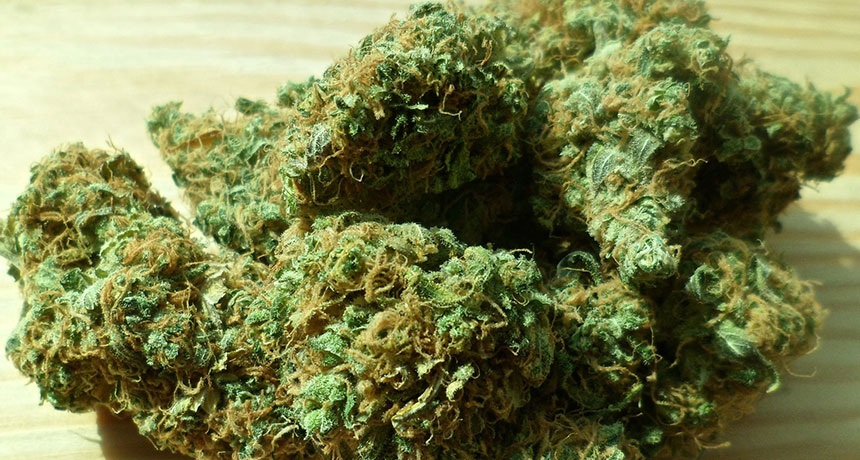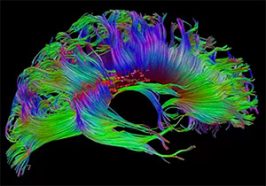Brain damage seen in potent-marijuana smokers
Brain scans showed abnormalities in some of the white matter

Today’s marijuana, like that shown here, tends to be especially rich in the mind-altering chemical THC. A new study has just linked use of such super-pot to a weakening in a critical structure in the brain.
cheifyc/Pixabay
People who smoke high-potency pot show signs of damage in a key part of their brain. The results of the new study, however, are limited. The brain scanning study was small. And it doesn’t show that marijuana caused the brain abnormality — only that the two go hand-in-hand.
But the finding suggests that potency matters, says Tiago Reis Marques. This coauthor of the study is a psychiatrist at King’s College London, in England. His team published its findings online November 27 in Psychological Medicine.
Just as vodka packs more of a punch than beer, a high-potency toke of cannabis — the name for the marijuana plant — delivers much more of the brain-active substance THC. That’s an abbreviation for tetrahydrocannabinol (TEH-trah-hy-drow-ka-NAB-ih-nol). It’s possible, Reis Marques says, that a bigger dose of THC simply may have stronger effects on the brain.
That’s important because as breeders have been improving their marijuana plants, THC levels have soared. Samples sold in Colorado, for instance, now have about three times as much THC as plants grown 30 years ago, a recent survey found.
The new study asked 43 healthy people to give a detailed history of their past drug use. About half said they smoke pot. These people then reported how potent that marijuana was. Reis Marques and his colleagues then scanned the brains of all participants. They used a method called diffusion tensor imaging. It shows the structure of white matter — neural highways that carry messages between different brain areas.

This suggests a link between smoking high-potency pot and white-matter damage. But the study can’t prove that cannabis was to blame. “These people could have had deviant brain structures prior to use,” says Mitch Earleywine. He’s a psychologist of the University at Albany in New York. He also serves on the advisory board of NORML. (That’s the National Organization for the Reform of Marijuana Laws.) The new results might also be due to use of other mind-altering drugs, he says. Cocaine, for instance, has been tied to changes in the corpus callosum, notes Earleywine.
Because the experiment looked only at brain structures, it’s unclear whether these changes would affect brain function. For instance, there are no data on whether these changes were linked to memory problems, impulsive behaviors or depression.
It’s also not known whether pot’s THC content affects white matter elsewhere in the brain, says Hans Breiter. He’s a neuroscientist and psychiatrist at Northwestern University in Evanston, Ill. “This study leaves out what is occurring with the rest of the white matter,” he says. It will be important to look at other parts of the brain, he says. He’s particularly interested in possible impacts on regions linked to memory and other behaviors that marijuana might affect.
With the growing legal availability of supercharged marijuana, understanding exactly what it does to the brain is more important than ever, Reis Marques says. This is particularly true, he argues, for young people. They may not realize the marijuana they are using may be much more powerful than ever before. “We are in a stage where there is missing [health effects] information, or the information is changing fast,” he says.
Power Words
(for more about Power Words, click here)
Cannabis sativa The Latin name of the plant whose leaves and seeds are smoked — as marijuana — to obtain a mind-altering “high.” The plant and drug products obtained from it are often just referred to as cannabis.
corpus callosum A bundle of nerve fibers that connects the right and left sides of the brain. This structure allows the two sides of the brain to communicate.
depression A mental illness characterized by persistent sadness and apathy. Although these feelings can be triggered by events, such as the death of a loved one or the move to a new city, that isn’t typically considered an “illness” — unless the symptoms are prolonged and harm an individual’s ability to perform normal daily tasks (such as working, sleeping or interacting with others). People suffering from depression often feel they lack the energy needed to get anything done. They may have difficulty concentrating on things or showing an interest in normal events. Many times, these feelings seem to be triggered by nothing; they can appear out of nowhere.
diffusion tensor imaging A brain-imaging technique. It uses magnetic resonance imaging (MRI) to see the brain’s white matter.
impulsive (n. impulsivity) Quick to act; not willing to wait. Not waiting for deliberation or a weighing of consequences.
marijuana A mind-altering drug. It is made from the leaves (and sometimes stems or seeds) of the Cannabis sativa plant.
neuroscience Science that deals with the structure or function of the brain and other parts of the nervous system. Researchers in this field are known as neuroscientists.
pot A slang term for marijuana.
psychiatry (adj. psychiatric) A field of medicine where doctors study and treat diseases of the human mind. Treatments may consist of talking therapies, prescription drugs or both. People who work in this field are known as psychiatrists.
psychology The study of the human mind, especially in relation to actions and behavior. To do this, some perform research using animals. Scientists and mental-health professionals who work in this field are known as psychologists.
tetrahydrocannabinol, or THC The primary active ingredient in marijuana responsible for the mind-altering “high” associated with smoking or eating parts of the Cannabis sativa plant.
toke A slang term for inhaling a quantity of smoke, usually marijuana smoke.
tract A particular, well-defined area. It can be a patch of land, such as the area on which a house is located. Or it can be a bit of real estate in the body, such as some particular area in the brain.
white matter One of the two main tissue types found in the brain and spinal cord. It consists mainly of bundles of nerve fibers.







